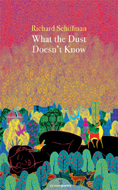 Richard Schiffman
Richard Schiffman
What the Dust Doesn’t Know
Salmon Poetry/Dufour Editions
Reviewer: David E. Poston
Richard Schiffman’s first full-length poetry collection, What the Dust Doesn’t Know, is dedicated to Mother Anasuya Devi of Jillellamudi and to “this sane and sacred Earth which sustains us all.” Author of biographies of the Jillellamudi Mother and Sri Ramakrishna, Schiffman is also an environmental journalist who has written extensively and eloquently about the rapidly unfolding disaster of climate change. As a journalist, Schiffman writes from a conviction that our very existence depends on transcending perspectives of both science and religion that have gotten our planet into a very real mess; in these poems, he displays a deep love for all the rich and fragile beauty of that existence.
That love is conveyed through poems lush with detail and enriched by the language of spirituality, as in the poem “Flimsy Ribbon,” which describes
…the earth itself
afloat the sea of night, hung pendulous with life—
which also came too soon, and sways on slender stalk,
and which is the improbable blossom of matter,
and may survive, or not, it is too soon to say.
To which some grinning God has tied
the breath of his own breath.
The title poem crackles with a vitality of diction reminiscent of Seamus Heaney:
…the red tent of a calyx
bursting from its crown of thorns,
is ravaged by a bee-like creature,
which wallows in that bristling
pollen cup, then staggers into air
bearing a scrim of dust,
dusting all its other crimson lovers
on the slope, which swell
with purpled fruit, also thorned—
like Jesus on his tree, waiting…
These poems are steeped in a long tradition of English verse, particularly that of the Romantics and the 20th Century high modernists. The Wordsworthian “East River” places its adult speaker looking over the railing at both the gritty reality of the present river and his own childhood, at
…the plunging black assassins, the cormorants,
and their cohorts, the gangster gulls skimming the knife-bright
waters, which abashed a boy once: shades of snitches
garbed in concrete overcoats communing with the fishes…
In “October Pond,” the speaker describes
[c]oming upon the greasy eye
of an old stock pond,
where cloud armies scud
across the glass-black pupil,
and blackbirds streak
like shooting stars,
leaf boats drifting: bloodstone,
amber, jasper and rose.
Later in the poem, the “last bee of the year” prompts the speaker to remember Wallace Stevens:
Perhaps the truth depends
upon a walk around the lake…
There are other allusions to Stevens, as well as echoes of Philip Larkin in “Family Tree” and of Dylan Thomas and “Fern Hill” at the end of the poem “Hope.” One of the most beautifully crafted poems, “Swallows,” brings Gerard Manley Hopkins to mind with its ending description of
…[f]lying exclamation points
banking and swerving like dervishes,
like shards of light, bouncing off the trampoline
of air. As if flight were not a flapping habit,
but a dizzy calling, less a way of moving
than of falling constantly into astonishment—
then catching themselves midair and winging off
to join the wheeling flock.
But this is a poetry that transcends those influences and traditions, subordinating human significance and power in the natural world, and expanding the customarily anthropocentric perspective. One poem I kept returning to is “The Snow Itself,” which begins
Sometimes a willow flailing in winter
winds scribes the snow with its long tapered
yellow fingernails.
The fickle human heart cannot decipher what the willow writes, “the mind cannot comprehend the heart,” and the snow will soon melt. The message is both ephemeral and eternal:
Yet for today, it is enough to be
this untrammeled brightness.
Not the wind, not the wind-whipped branch,
not what is written by the branch,
nor the knower, nor the unknower of that.
Not the heart, not the mind.
Here Schiffman presents the world as palimpsest, with the snow as “this white and endlessly inscribed astonishment.”
These poems take us out of the urban grid into the estuaries and bays, across oceans, and even—in the poem “Wobble”—across the universe. In “City of Tides,” a Quechuan shaman leads us beyond
the brittle artifices of skyline…
the caverned subways, the noose-like highways—
…the tide-swept, mercurial light
at the edges, shimmering in the rivers
where the city becomes unstitched…
The poem ends with the promise that some day
we too would see those waters
glinting beyond the City of this World.
The poetic geography ranges from the American Southwest to the edge of Afghanistan’s Dasht e Margo (“Herat 1974”), from prayer boats on the Ganges at Hardwar to penitents davening at the Western Wall. Spiritually, the poems touch those moments of wonder that are the common ground of all religious experience. But here, traditional religions do not provide answers. Allah, when questioned by the angels in “Tongue’s Untied,” says only “I know what you do not.” Buddha responds to a question by twirling a flower.
For answers, we must turn to our new prophet, which will be a little bird. It is the flora and fauna in these poems that pull us beyond our solipsistic perspective to a higher spiritual plane. We are invited to learn from the kiku, from “Crows and Hawks,” from hummingbirds and darting minnows and horned toads—and from “Bristlecone Pines,” which were alive in the time of Buddha and Turtle Island. The moth flying into the sun in “Moth Koan” may understand more about the soul than the boy at Hiroshima or the dragonfly he reaches for in “Shadows.” In “Sermon to the Pooches,” we view the world through the eyes of the doggy prophets who find God in the lowliest of places, “in the very night soil of the Everlasting.”
We are vividly called to task in another sermon, “Sermon to the Trash,” for
…every foul and unnatural thing
under the petrochemical sun,
which clogs the primordial waters
like unforgiveness in the heart,
to muck up the spawning grounds of love,
and choke the teeming rapture of the marshes,
and sore rebuke the eyes of the disposer.
“Kiss of Death,” written in response to a Gerald Herbert photograph from the Deepwater Horizon oil spill, provides another image of a dragon fly, this one’s “wings smeared with earth’s black blood…a wee-Jesus on a crucifix of grass.” Though the poem describes it as a mute “effigy of itself,” it eloquently rebukes us all.
So what should be the place of humans in this wondrous and fragile universe? The answer is found in “Pilgrims,” where Tibetan pilgrims move like inchworms,
…their bodies bent
then bent again to measure themselves against
the world. And though they came up short
each time, they marked each time their human
frame upon the earth it came from.
“This world itself is the Kingdom of God,” said Mother Anasuya Devi. We should all be grateful that Richard Schiffman is at work, using the poetic process to continue the tradition of “grasping at the ungraspable world,” all the while calling us into it.

